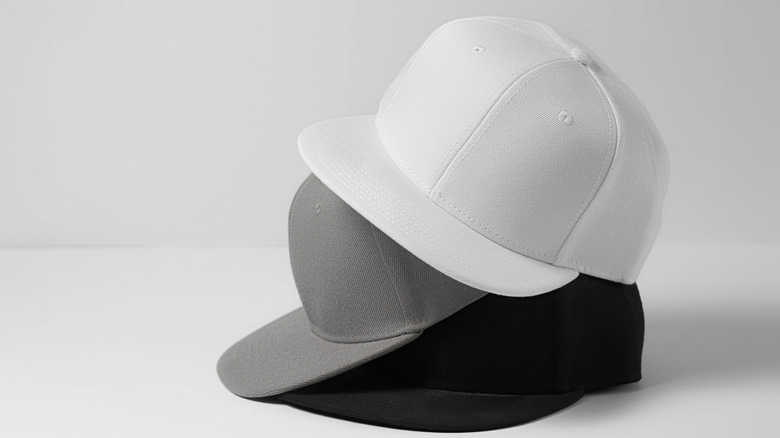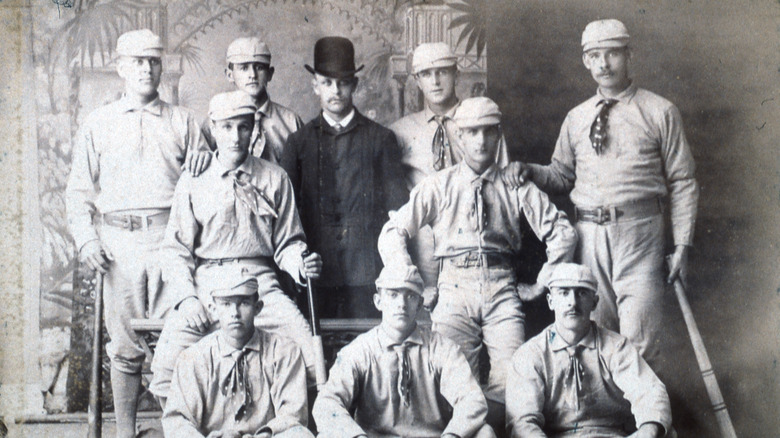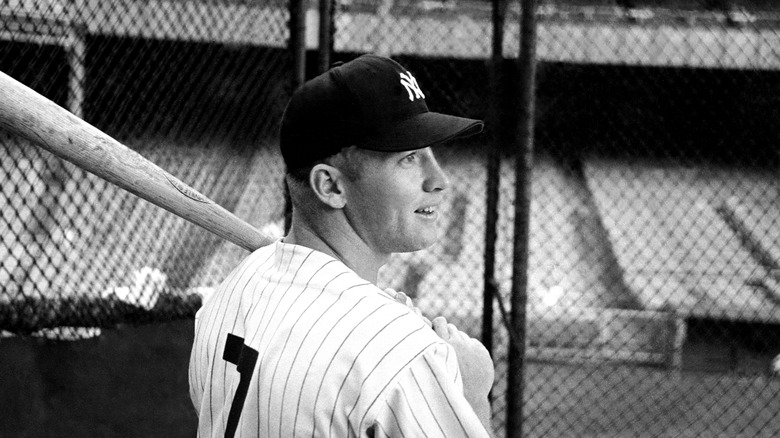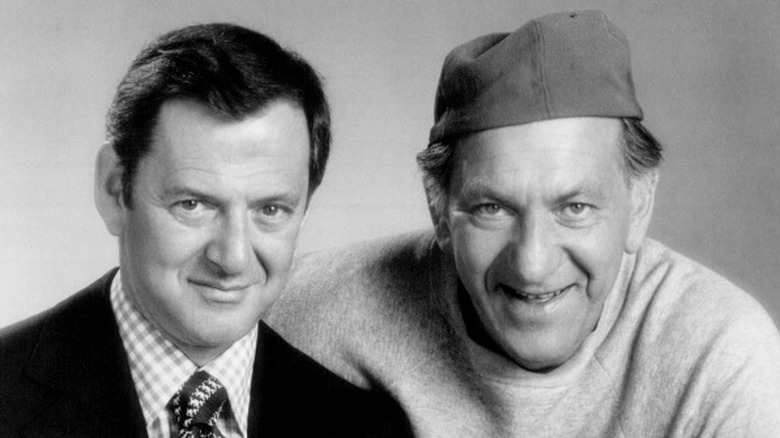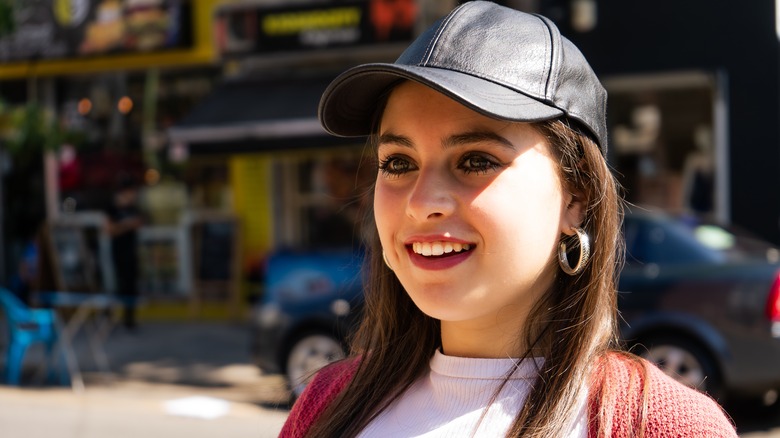Why Wearing Baseball Caps Used To Be Majorly Frowned Upon
Hats are a strange article of clothing. They often serve a utilitarian purpose, usually keeping the sun or rain out of your eyes, or body heat from escaping out the top of your noggin. The most common headgear seen today, by a significant margin, is the humble baseball cap. They've become so ubiquitous in our society that you rarely even notice someone had one on. If you had lunch with someone a week ago and were asked if they were wearing a baseball cap, your answer would probably be, "Uh ... I'm not sure. Maybe?"
Now, if your hypothetical dining partner joined you wearing any other kind of hat — a sombrero, a bowler hat, or maybe even one of those beanies with the propeller — and you were asked if they were wearing a hat, you'd respond "Yes! What was the deal with the propeller?"
So it might be a surprise that something we are so used to today used to be considered a major fashion faux pas in an era when other headgear like derbies, porkpie hats, and fedoras ruled the roost, per The New York Times.
The origin of the baseball cap
First, some definitions. A hat is a piece of headgear with a shaped crown and a brim that circles all the way around the crown, as Garment Printing in the U.K. explains. A cap, on the other hand, tends to have a shapeless crown and no brim — instead, there's a visor. When discussing the birth of the baseball cap, the logical place to start is on the baseball field. However, while hats had a foothold in the early version of America's pastime, the caps that became synonymous with the sport came a little bit later. According to The New York Times, the first documented organized baseball team, The New York Knickerbocker Base Ball Club, wore straw hats because they were in public, and in the late 1840s, men just wore hats because it was the thing to do whenever they were in public. Players still needed to keep the sun out of their eyes while trying to track down a fly ball, and to do this they opted for any kind of hat with a brim. According to Vogue Australia, popular styles in this era were straw boater hats or pillbox caps.
In 1858, the Brooklyn Excelsiors started wearing something reminiscent of a modern ball cap when they started wearing short-brimmed hats based on those worn by jockeys. As the 20th century loomed, this style of hat continued to evolve. The 1890s saw the addition of holes to allow for cooling, and by 1901, the first hat with a team logo appeared on the heads of Detroit Tigers players.
Modern baseball caps take shape
Baseball caps continued to evolve rapidly in the early 1900s. Stitched brims were introduced in 1903, when Spalding — who at the time was one of the leading bat manufacturers — decided to get into the hat game, per Routine. Around this time, the baseball cap went from being an optional piece of equipment to being part of the standardized uniform worn by all players. Though, as Vogue Australia notes, these hats were limited to the field. The stands were still a sea of bowlers and fedoras and it would stay that way for a few more decades.
In the years that followed, the caps morphed into their modern forms. The bills became longer in the 1920s and '30s and eventually stiffened up as well. The panels that make up the hat's crown became taller in the front, which served as a better place for the team to sew on their logo. According to The New York Times, in 1959, New Era introduced what is essentially the modern baseball cap. They called it the 59Fifty, and while the original versions were made of wool, whereas the modern ones are made of polyester, the 59Fifty is still the official onfield cap worn by Major League Baseball players.
Wearing a baseball cap off the field used to have a different connotation
The kind of hat a person chose to wear said a lot about them, much more than whether they were a Yankees or a Red Sox fan. According to The New York Times, hats were an indicator of a person's social status and even where they were from. In those days, a ball cap wasn't exactly a symbol of the upper crust. In an essay published in the Wall Street Journal in 1999, it's pointed out that in prior times, ball caps — besides athletes — were mostly worn by children. Wearing a hat with a brim was a mark of growing up. Another essay, at the University of Chicago, points out that by mid-20th century, caps were considered the apparel of the working class, not professionals. In the book "Ball Cap Nation," author James Lilliefors writes of how off-field baseball caps were perceived. For instance, in "The Odd Couple," the character Oscar Madison — played by Walter Matthau in the 1968 film and Jack Klugman (above, right) in the TV series — wore a New York Mets cap as a way of hammering home his slovenly ways.
This started to change in the 1970s, as perceptions of baseball caps underwent a complete 180. The first generation of kids who grew up playing Little League baseball reached adulthood and brought with them an affinity for ball caps. Thomas Magnum on the original 1980s "Magnum, p.i." wore a ball cap. Tom Selleck's portrayal of Magnum differed from Oscar Madison in that Magnum was undeniably cool and still wore a Detroit Tigers ball cap.
Baseball caps become commonplace
Today, baseball caps are far and away the most commonly seen piece of headgear and are a staple of many wardrobes. According to The New York Times, one of the appeals of the baseball cap is that despite its ubiquity, there are ways for the wearer to use the item to express themselves. The way a person tilts their cap, bends or doesn't bend the brim, wears it forward or backward, or decides to leave that shiny sticker in place, says a lot about them and the image they're trying to project to others through their cap. This idea is nothing new. It's the same idea as in days of yore, when wearing a specific style of hat was a status symbol or showcased regional identity. Wearing a Chicago Cubs cap, for instance, versus wearing a Chicago White Sox cap is a way of showcasing regional identity even in the same city.
Styles within baseball caps also change and evolve, go out of style and come back. In the 1990s, '47 Brand started selling so-called unstructured caps. These caps remove the typically stiff front panels in favor of soft panels that comform to the wearer's head. These have become popular, as have caps with different kinds of adjustable closures, like snapback and strapback caps.
